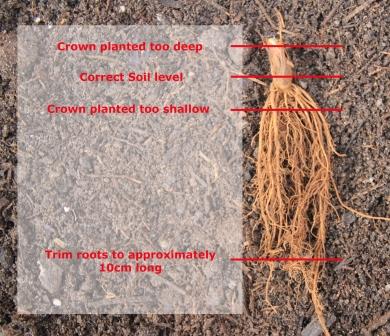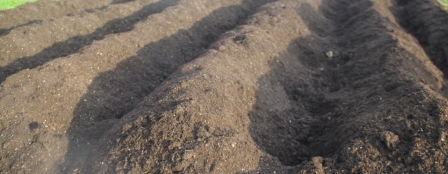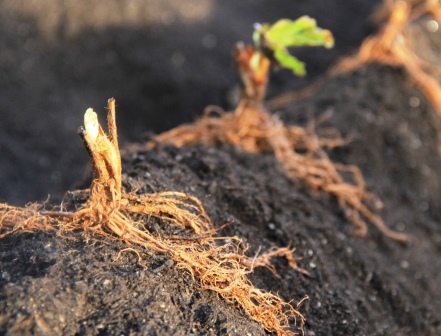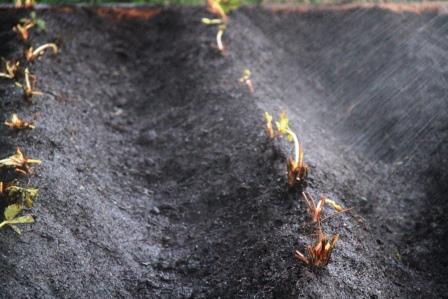This blog post is specifically about planting strawberry runners. Why not check out our guide on How to Grow Strawberries as well?
Strawberries can “reproduce” either through seeds or from runners. Strawberry runners are horizontal stems that run above the ground and produce new “baby” clone plants at the end of the long horizontal stem. These baby plants (which are a genetic copy of the mother plant), set roots and grow into the ground surrounding the mother plant. Strawberry runners are properly termed “stolons”, but to keep it simple, we’ll refer to them by the more commonly recognized term “runners”. Runners are a more reliable and preferred method for establishing strawberries in your garden. You can obtain strawberry runners from nurseries or online. They are sold as a crown with a spindly mass of bare roots.
These rather uninspiring looking things produce some of the tastiest fruit over summer and autumn. Nurseries in Melbourne and all over the temperate regions of Australia (eg., NSW, SA, TAS & VIC) will start stocking these runners in early June. This is because winter (from June and as late as October) is the time to plant them. If you live in the sub tropics strawberry planting is best done in autumn. Once planted, the new leaves will be produced from the crowns in spring.

If you buy your runners from reputable nurseries or mail order, they’ve hopefully been grown in conditions that are virus free. Such runners are called “certified runners”. Certified Strawberry Runner Growers actually encourage the mother plants to send out runner plants by removing all the flowers and fruit.
When you have your strawberry runners, you should prepare them for planting straight away. Unwrap them wash and their roots well in water. Discoloured leaves should be pinched off. Trim the roots back to around 10cm. Plant your runners the same day that you prepare them. If you are not ready to plant them on the same day, you should store them in the refrigerator, and plant them as soon as possible.
If you buy your runners from reputable nurseries or mail order, they’ve hopefully been grown in conditions that are virus free. Such runners are called “certified runners”. Certified Strawberry Runner Growers actually encourage the mother plants to send out runner plants by removing all the flowers and fruit.
When you have your strawberry runners, you should prepare them for planting straight away. Unwrap them wash and their roots well in water. Discoloured leaves should be pinched off. Trim the roots back to around 10cm. Plant your runners the same day that you prepare them. If you are not ready to plant them on the same day, you should store them in the refrigerator, and plant them as soon as possible.
How to Plant Your Strawberry Runners

It is important to plant runners at the correct depth. Planting your runners too deeply will cause the crown (the bit from where the leaves grow from) to rot. Remember, strawberries don’t like wet feet at all. On the other hand, planting your runners too shallowly will leave the roots exposed. The plant may not establish correctly with exposed roots. Do not allow the roots to double back, or fold over when planting.
If you’re planting out your runners into a large garden bed it’s a good idea to plant them in mounds. This will help to ensure they have good drainage, during times of high rainfall. To do this, mound up the soil into long ridges about 10cm high. This mounding is best done by hand, lightly pressing the soil together as you go. Planting into smaller raised beds or containers don’t need to utilize the mounded ridge technique.

Usually I plant strawberry runners 30 to 40cm apart. If using drip irrigation, then plant a runner per drip hole which will maintain a spacing of 30cm. Place the strawberries at the required spacing. Spread the roots as you go so that the runners sit up across the ridges.

Now cover over the roots with more soil. To help improve drainage, make sure you maintain the mounded shape of the ridge. Most importantly, check that the base of crown of the runner is sitting just on the soil surface.

At this point, the runners should be watered in well. Some worm wee or worm juice may help them become established. Now leave your runners to become established and grow.
This blog post is specifically about planting strawberry runners. Check out our guide on How to Grow Strawberries for more information on caring for your strawberries once they have established.
Looking to supplement your strawberries? Why not try growing raspberries or blueberries as well. They are just as easy to grow and perhaps even more productive!
Check out:


looking forward to having sweet bowl of strawberries and cream
Us too!
Hi I am in Victoria could anyone explain to me how to make seedlings at backyard .I collected some seeds from my veggie patch.
Hi Herman,
Normally strawberries are grown from runners not seeds. The exception being alpine strawberries. Alpine strawberry seeds can be sprinkled on the to of some seed raising mix and kept moist until germination.
Good Luck & Happy Gardening
Duncan
Question. Do you have to keep the rain off your strawberry plants? If so, how?
We don’t keep the rain off the plants – they need water to grow and rain is the best way to water them!
Thanks for your helpful and interesting newsletter Duncan. It is encouraging to read that you as a gardening expert have disappointments in the garden too. (Not that I’m happy about it).
Just about apricot trees. I noticed you mentioned some gumosis on yours. I noticed some sap on the lower trunk of my young apricot tree which seems a bit of a fussy princess – always some issue. It seemed to settle down but just last week I noticed two lots of sap on an upper branch. What’s your advice now? Thanks
Hi Rose,
Yes, apricots are fussy things and are very prone to gummosis. So you need to place them in the best spot in your garden for them to thrive (as apposed to a plum which can go anywhere). Often gummosis can lead to brown rot in fruit (especially in humid years). Gummosis is systemic, that is once the plant is infected with it, it will spread right through the plant and it will have it forever. If i find that the fruit becomes affected I will probably remove the tree and replace it. I’ll wait and see before doing anything that drastic though.
Glad you find the newsletter helpful (including my failures – it’s how I learn!)
Happy Gardening
Duncan